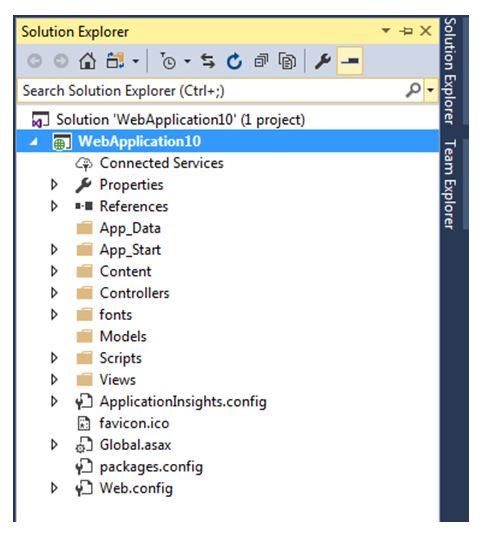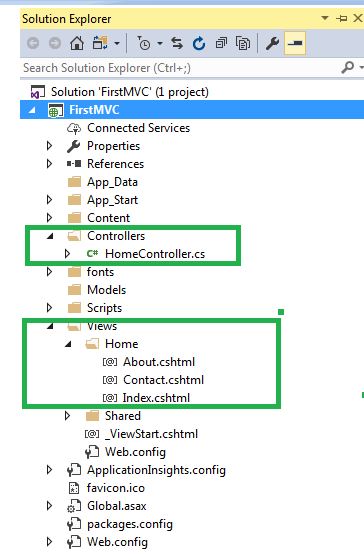ASP.NET MVC : Getting Started (Part 1)
Introduction
This article explains the basic of ASP.NET MVC and explains the main advantages, version history, and Environment setup and folder structures. Here we can learn how to start first ASP.NET MVC application.
What is an ASP.NET MVC
MVC is an architectural pattern. Separate the application into three main components. The three compounds are Model, View, and Controller. Handle specific development aspects of an application. MVC is the most frequently used industry-standard web development framework.
Model
Model is a simple class. It is a shape of the data. The model contains business logic. Controller and View can accessible the model. The model helps to pass the data from the controller to view and view to the controller. Using the model we are displaying data in the view page.
View
The view is a user interface. It is used to display the entire data using the model. We are using two type of view engines in view. One is the traditional view engine and another one is the Razor view engine. Traditional view engine is normal “.ASPX” page.
Razor view engine is used to develop a normal page design using Html Helper controls. It contains “.CSHTML” extension. A syntax-wise little bit different in both view engines.
Controller
The controller is a heart of MVC and it handles the user request. It is a simple class and it is inherited by. A controller can access the model and pass data to view with the help of a model. We can pass the data between the controller and view using View Data, Temp Data View Bag. The controller is intermediate between model and view.
Model-View-Controller
Basic Work Flow of MVC
MVC workflow starts with the user’s request. Based on the request, first, go the controller then go to the corresponding action method. In the action method, we are calling all layers like business logic layer, data access layer.
Once reach action method then go the go to the Data access layer. Some time while requesting, the request contains some input data that input data bind with the model then go to the data access layer.
Request reaching data access layer then go to the corresponding database. Fetching the data from a database based on the request then aging goes back to the reverse format. After fetching data and binding in the model and go to the action method.
Action method returns the result to the corresponding view with the help of the model now. Now the user gets the response. Action method returns result in a different format.
Advantages of MVC
- Separation Of Concern (SOC) is the main advantages of MVC. Here we are separating Mode, View, and Controller.
- We can easily maintain a MVC application.
- Test Drive Development (TDD) is another one main advantages. We can create an application with a unit test.
- We can write our own test cast.
- Split the application and many developers can work at a time without affecting each other.
- MVC application is a default responsive web site and mobile template.
- We can create our own view engine and syntax-wise easily rememberable.
Is MVC Replacing ASP.NET Web Forms?
No, MVC is not replacing ASP.NET web forms. It is another choice for developers to use. Many companies are still using the traditional ASP.NET web form. MVC is now using many companies and it is very famous. Bases on the customer opinion and project structure, whether they use the traditional ASP.NET application or ASP.NET MVC.
Folder Structure of MVC
We can see the basic folder structure of MVC in below screenshot. We can find the Model, View, and Controller in below screenshot while opening ASP.NET MVC application, it is default contains Model, View, and Controller.
Environment Setup for ASP.NET MVC
Visual Studio 2017 is the latest version of visual studio. It is support for all versions of ASP.NET MVC and ASP.NET MVC Core. We can install Visual Studio 2017 and create a web application using ASP.NET MVC.
First ASP.NET MVC Application
Step 1
Open Visual Studio 2017, Go to File à New à Project. Select Web à ASP.NET Web Application (.NET Framework). Give Project name and click ok.
Step 2
Select MVC in the template window and click ok. Once click MVC we can see the description on the right side as looks like below screenshot.
Step 3
We can see the folder structure looks like below screenshot. We can find the Model-View-Controller architecture. The home controller is a default controller in the Controller folder. The home controller contains three action results.
namespace FirstMVC.Controllers
{
public class HomeController : Controller
{
public ActionResult Index()
{
return View();
}
public ActionResult About()
{
ViewBag.Message = "Your application description page.";
return View();
}
public ActionResult Contact()
{
ViewBag.Message = "Your contact page.";
return View();
}
}
}
Step 4
Build our ASP.NET MVC application, if build successes run the application. We can see the looks like the below screenshot.
Version History of MVC
- ASP.NET MVC 1
- Released on Mar 13, 2009
- Runs on .Net 3.5
- Visual Studio 2008
- ASP.NET MVC 2
- Released on Mar 10, 2010
- Runs on .Net 3.5, 4.0
- Visual Studio 2008 & 2010
- ASP.NET MVC 3
- Released on Jan 13, 2011
- Runs on .Net 4.0
- Visual Studio 2010
- ASP.NET MVC 4
- Released on Aug 15, 2012
- Runs on .Net 4.0, 4.5
- Visual Studio 2010 sp1 & 2012
- ASP.NET MVC 5
- Released on 17 October 2013
- Runs on .Net 4.5
- Visual Studio 2013
Conclusion
This article explained how to start ASP.NET MVC, the basic idea of MVC, the workflow of MVC, and the advantages of MVC. I hope this is very helpful for new learners.






